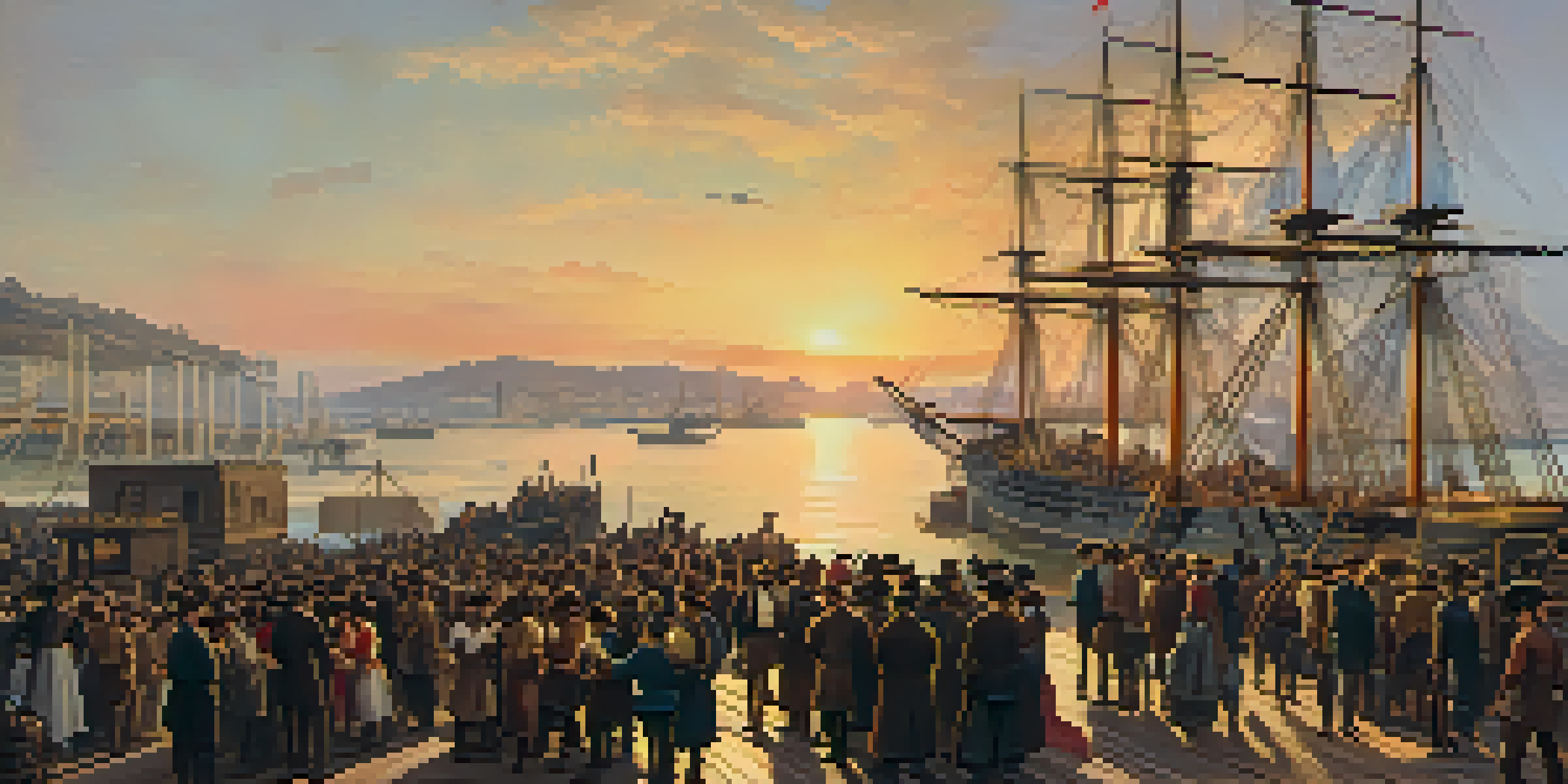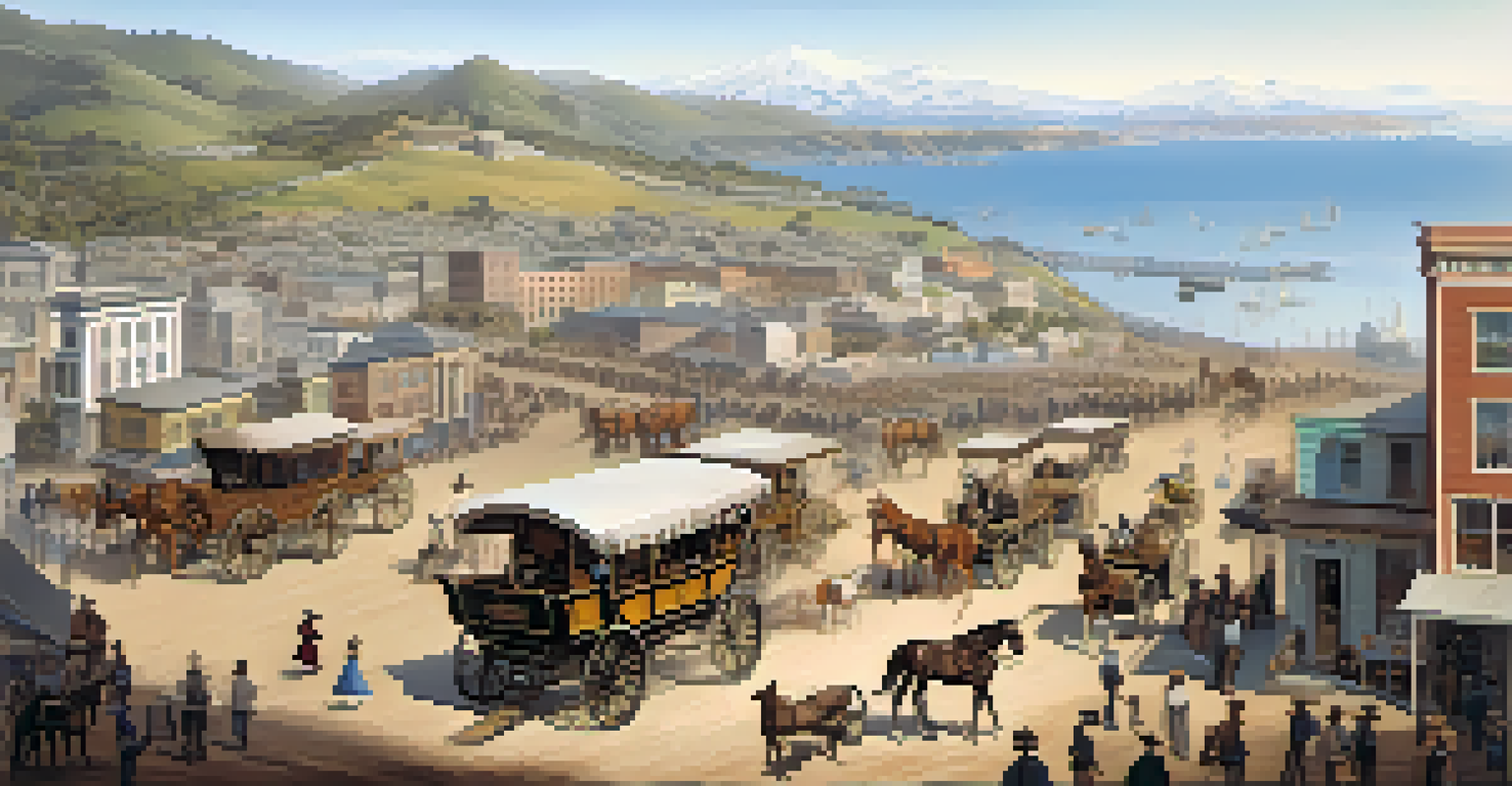The Gold Rush of 1849: Transforming San Francisco's Landscape

The Spark of the Gold Rush: A Nation's Discovery
In January 1848, gold was discovered at Sutter's Mill in California, setting off one of the most significant migrations in American history. News of this find spread like wildfire, attracting fortune seekers from all over the country and even abroad. The excitement was palpable, as dreams of wealth and a better life drove thousands to the West Coast, changing the face of San Francisco forever.
The Gold Rush is a story of adventure, courage, and the pursuit of dreams, but it also reveals the complexities of human nature and society.
These gold-seekers, known as '49ers,' arrived in San Francisco by various means—some braved treacherous sea voyages, while others trekked overland through rugged terrain. Every arrival brought new energy and a wave of diverse cultures, as people from different walks of life converged in search of gold. The once sleepy settlement of San Francisco quickly transformed into a booming hub, bustling with activity and ambition.
This massive influx of people prompted rapid development in infrastructure, commerce, and social services. The city, which had previously been a modest port town, began to evolve into a major urban center. As the population surged, so did the challenges, creating a unique blend of opportunities and obstacles that would shape the city’s future.
Building a City: Infrastructure and Growth
As the Gold Rush progressed, the urgent need for infrastructure became evident. Makeshift shelters and tents began to dot the landscape, but soon, more permanent structures were needed to accommodate the growing population. Entrepreneurs seized the opportunity to construct hotels, saloons, and shops, turning San Francisco into a vibrant, albeit chaotic, city.

The demand for services skyrocketed, leading to the establishment of banks, transportation systems, and even schools. Streets were laid out, and public services began to take shape, with the city striving to maintain order amidst the gold fever. This growth laid the groundwork for San Francisco’s future as a bustling metropolis and a pivotal economic center.
Gold Rush Transformed San Francisco
The discovery of gold in 1848 catalyzed a massive migration, transforming a modest port town into a bustling urban center.
However, this rapid expansion was not without its challenges. Issues like sanitation, crime, and housing shortages arose, leading to a mix of innovation and struggle. The city’s leaders had to think creatively to address these problems, showcasing the resilience and determination of its inhabitants.
Cultural Melting Pot: Diversity in the Gold Rush
The Gold Rush attracted a diverse group of individuals, creating a cultural melting pot in San Francisco. Miners, merchants, and prospectors hailed from various backgrounds, including the East Coast, Europe, Asia, and South America. This influx of cultures contributed to a rich tapestry of traditions, languages, and cuisines, making the city unlike anywhere else in the United States.
San Francisco is a city where the past, present, and future coexist, shaped by the stories of those who sought fortune and a better life.
With so many different cultures colliding, San Francisco became a hub of innovation and creativity. From the establishment of Chinese communities to the introduction of new culinary delights, the city's cultural landscape expanded significantly. The blending of these diverse influences would eventually shape the city’s identity for generations to come.
However, this diversity also brought challenges, such as discrimination and conflict among different groups. The social dynamics of the Gold Rush era highlighted the complexities of coexistence, foreshadowing the struggles that would continue throughout the city's history. Nonetheless, the melting pot nature of San Francisco became one of its defining features.
Economic Boom: Wealth and Opportunity
The Gold Rush created an unprecedented economic boom in San Francisco. As wealth poured into the city, businesses flourished, and job opportunities multiplied, attracting even more people eager to stake their claim in this land of opportunity. The economy diversified beyond mining, with industries such as shipping, retail, and services experiencing explosive growth.
Many individuals who arrived with dreams of gold found success in unexpected ways. Some became merchants, selling supplies and goods to miners, while others invested in real estate, capitalizing on the city's rapid expansion. This economic shift not only transformed the landscape but also laid the foundation for San Francisco's reputation as a land of opportunity.
Diverse Cultures Shaped the City
The influx of people from various backgrounds during the Gold Rush created a rich cultural tapestry, making San Francisco a unique melting pot.
However, this rapid growth also led to economic inequalities. While some struck it rich, many others struggled to make a living. The disparity in wealth created tension within the community, highlighting the complexities that often accompany prosperity.
Environmental Impact: A Changing Landscape
The rush for gold had significant environmental consequences that are still felt today. Rivers were diverted, forests cleared, and landscapes altered as miners sought their fortunes. Techniques such as hydraulic mining caused severe erosion and pollution, drastically changing the natural environment around San Francisco.
This environmental degradation raised concerns among some residents and sparked early conservation movements. The tension between economic development and environmental preservation became evident as the city grappled with its growing footprint. San Francisco's landscape was not just changing physically; the ideals of progress and sustainability were also being challenged.
As the city evolved, the lasting impact of the Gold Rush on the environment prompted future generations to reconsider their relationship with nature. Today, San Francisco's ongoing efforts in sustainability and conservation reflect the lessons learned from this pivotal period in its history.
Social Dynamics: Challenges and Resilience
The Gold Rush era brought about significant social challenges in San Francisco. With a rapidly growing population, issues such as crime, lawlessness, and social unrest became prevalent. The lack of established governance meant that citizens often took matters into their own hands, leading to the formation of vigilante groups seeking justice.
Despite these challenges, the community displayed remarkable resilience. People banded together to create social organizations, support systems, and even a nascent legal framework to address the chaos. This sense of community was vital in navigating the tumultuous landscape, showcasing the human spirit's ability to adapt and thrive.
Economic Boom and Inequality Emerged
While the Gold Rush spurred significant economic growth and opportunities, it also highlighted stark disparities in wealth among its residents.
The social dynamics of this era laid the groundwork for future civic engagement and activism. As San Francisco continued to grow, the lessons learned from the Gold Rush would inform the city’s development, highlighting the importance of community and collaboration in overcoming adversity.
Legacy of the Gold Rush: San Francisco Today
The legacy of the Gold Rush is deeply woven into the fabric of San Francisco today. The city, once a small settlement, is now a global icon known for its innovation, culture, and diversity. The spirit of adventure and entrepreneurship that characterized the Gold Rush era lives on in the city's thriving tech industry and creative communities.
San Francisco's historical landmarks, such as the Golden Gate Park and the Ferry Building, serve as reminders of this transformative period. These sites attract millions of visitors each year, linking the past with the present and preserving the stories of those who came before. The Gold Rush not only shaped the city's physical landscape but also its cultural and economic identity.

As we reflect on this critical chapter in history, it’s clear that the Gold Rush was more than just a quest for gold; it was a catalyst for change. The challenges and triumphs experienced during this era continue to influence San Francisco’s evolution, making it a city rich in stories, resilience, and innovation.